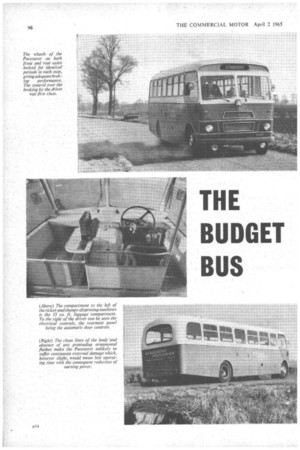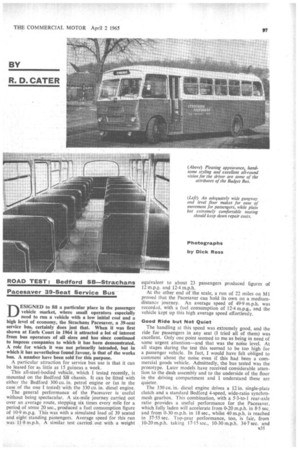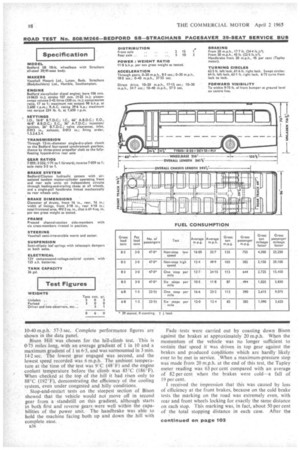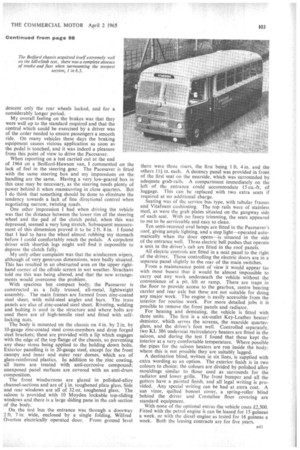THE BUDGET BUS
Page 98

Page 99

Page 100

Page 105

If you've noticed an error in this article please click here to report it so we can fix it.
ROAD TEST: Bedford SB—Stra.cha.ns ,Pacesaver 39-Seat Service Bus DESIGNED to fill a particular place in the passenger vehicle market, where small operators especially need to run a vehicle with a low initial cost and a high level of economy, the Strachans Pacesaver, a 39-seat service bus, certainly does just that. When it was first shown at Earls Court in 1964 it attracted a lot of interest from bus operators of all sizes and has since continued to impress companies to which it has been demonstrated. A role for which it was not ,primarily intended, but in which it has nevertheless found favour, is that of the works bus. A number have been sold for this purpose.
A particular attraction for service bus use is that it can be leased for as little as 15 guineas a week.
This all-steel-bodied vehicle, which I tested recently, is mounted on the Bedford S13 chassis. It can be fitted with either the Bedford 300 cu. in. petrol engine or (as in the case ofthe one I tested) with the 330 Cu. in. diesel engine.
The general performance of the Pacesaver is useful without being spectacular. A six-mile journey carried out over an average route, stopping six times every mile for a period of some 20 sec., produced a fuel consumption figure of 10-9 m.p.g. This was with a simulated load of 39 seated and eight standing passengers. Average speed for this run was 11.8 m.p.h. A similar test carried out with a weight equivalent to about 23 passengers produced figures of 12 m.p.g. and 12-4 m.p.h.
At the other end of the scale, a run of 22 miles on Ml proved that the Pacesaver can hold its own on a mediumdistance journey. An average speed of 49-9 m.p.h. was recorded, with a fuel consumption of 12-4 m.p.g., and the vehicle kept up this high average speed effortlessly.
Good Ride but Not Quiet
The handling at this speed was extremely good, and the ride for passengers in any seat (I tried all of them) was excellent. Only one point seemed to me as being in need of some urgent attention—and that was the noise level. At all stages during the test this seemed to be too high for a passenger vehicle. In fact, I would have felt obliged to comment about the noise even if this had been a commercial goods vehicle. Admittedly, the bus tested was the prototype. Later models have received considerable attention to the dash assembly and to the underside of the floor in the driving compartment and I understand these are quieter.
The 330 Cu. in. diesel engine drives a 12 in. single-plate clutch and a standard Bedford 4-speed, wide-ratio synchromesh gearbox. This combination, with a 5.3-to-1 rear-axle ratio provides a useful performance for the Pacesaver, which fully laden will accelerate from 0-20 m.p.h. in 8-5 sec. and from 0-30 m.p.h. in 18 sec., whilst 40 m.p.h. is reached in 37.55 sec. Top-gear performance, too, is fair, from 10-20 m.p.h. taking 17.15 see„ 10-30 m.p.h. 34-7 sec. and
10-40 m.p.h. 57-3 sec. Complete performance figures are shown in the data panel.
Bison Hill' was chosen for the hill-climb test. This is 0-75 miles long, with an average gradient of 1 in 10 and a maximum gradient of 1 in 6-5, and was surmounted in 3 min. 14-2 sec. The lowest gear engaged was second, and the lowest speed recorded was 6 m.p.h. The ambient temperature at the time of the test was 9'C (48°F) and the engine coolant temperature . before the climb was 85?C (186°F). When checked at the top of the hill it had risen only to 88°C. (192'F), demonstrating the efficiency of the cooling system, even under congeSted and hilly conditions. Stop-and-restart tests on the steepest section of Bison showed that the vehicle would not move off in second gear from a standstill on this gradient, although starts in both first and reverse gears were well within the capabilities of the power unit. The handbrake was able to hold the machine facing both up and down the hill with complete ease.
B36 Fade tests were carried out by coasting down Bison against the brakes at approximately 20 m.p.h. When the momentum of the vehicle was no longer sufficient to sustain that speed it was driven in top gear against the brakes and produced conditions which are hardly likely ever to be met in service. When a maximum-pressure stop was made from 20 m.p.h. at the end of this test, the Tapley meter reading was 63 per cent compared with an average of 82 per cent when the brakes were cold-a fall of 19 per cent.
1 received the impression that this was caused by loss of efficiency at the front brakes, because on the cold brake tests the marking on the road was extremely even, with rear and front wheels locking for exactly the same distance on each stop. This marking was, in fact, about 50 per cent of the total stopping distance in each case. After the descent only the rear wheels locked, and for a considerably longer period.
My overall feeling on the brakes was that they were well up to the standard required and that the control which could be exercised by a driver was of the order needed to ensure passengers a smooth ride. On many vehicles these days the braking equipment causes vicious application as soon as the pedal is touched, and it was indeed a pleasure from this point of view to drive the Pacesaver.
When reporting on a test carried out at the end of 1964 on a Bedford-Hawson van, I commented on the lack of feel in the steering gear. The Pacesaver is fitted with the same steering box and my impressions on the handling are the same. Having a very low-geared box in this case may be necessary, as the steering needs plenty of power behind it when manceuvring in close quarters. But 1 do think that something should be done to eliminate the tendency towards a lack of fine directional control when negotiating narrow, twisting roads. One other impression I had when driving the vehicle was that the distance between the lower rim of the steering wheel and the pad of the clutch pedal, when this was depressed, seemed a very long stretch. Subsequent measurement of this dimension proved it to be 2 ft. 8 in. I found that I had to have the wheel almost rubbing my stomach before I could comfortably reach the pedals. A corpulent driver with shortish legs might well find it impossible to depress the clutch fully. -My only other complaint was that the windscreen wipers, although of very generous dimensions, were badly situated. This has resulted in an obstructed area on the upper righthand corner of the offside screen in wet weather. Strachans told me this was being altered, and that the new arrangements would overcome the problem.
With spacious but compact body, the Pacesaver is constructed as a fully trussed, all-metal, lightweight assembly. The main frames are formed from zinc-coated steel sheet, with mild-steel angles and bars. The truss panels are also of zinc-coated steel sheet. Riveting, welding and bolting is used in the structure and where bolts are used there are of high-tensile steel -and fitted with selflocking nuts. The body is mounted on the chassis on 4 in. by 2 in. by 10-gauge zinc-coated steel cross-members and drop forged steel brackets; these are provided with a lip which engages with the edge of the top flange of the chassis, so preventing any shear stress being applied to the holding down bolts. Exterior panelling is in 20-gauge steel, except for the front canopy and inner and outer rear domes, which are of glass-reinforced plastics. In addition to the zinc coating, all items are treated with anti-corrosive compound; unexposed panel surfaces are covered with an anti-drum composition.
The front windscreens are glazed in polished-alloy channel-sections and are of in. toughened plate glass. Side and rear windows are all of 32 oz. toughened glass. The saloon is provided with 10 Moyden lockable top-sliding windows and there is a large sliding pane in the cab section of the body.
On the test bus the entrance was through a doorway 2 ft. 7 in. wide, enclosed by a single folding, Wilfred Overton electrically operated door. From ground level there were three risers, the first being 1 ft. 4 in. and the others I l. in. each. A decency panel was provided in front of the first seat on the nearside, which was surrounded by adequate grab-rails. A compartment immediately on the left of the entrance could accommodate 15 cu.-ft. of luggage. This can be replaced with two extra seats if required at no additional charge.
Seating was of the service bus type, with tubular frames and Vitafoam cushioning. The top rails were of stainless steel, as were the grab plates situated on the gangway side of each seat. With no fancy trimming, the seats appeared to me to be serviceable and easy to clean.
Ten semi-recessed oval lamps are fitted in the Pacesaver's roof, giving ample lighting, and a step light—operated automatically when the door opens—is situated in the side of the entrance well. Three electric bell pushes that operate a unit in the driver's cab are fitted in the roof panels. All electric controls are fitted in a neat panel to the right of the driver. Those controlling the electric doors are in a separate panel slightly to the rear of the main switches.
From a maintenance point of view it would appear (as with most buses) that it would be almost impossible to carry out any work underneath the vehicle without the convenience of a pit, lift or ramp. There are traps in the floor to provide access to the gearbox, centre bearing carrier and rear axle but these are not suitable for doing any major work. The engine is easily accessible from the interior for routine work. For more detailed jobs it is possible to remove the front panels and radiator.
For heating and demisting, the vehicle is fitted with three units. The first is a six-outlet Key-Leather heater/ demister, which serves the screens, the nearside quarterglass, and the driver's foot well. Controlled separately, two KL 386 underseat recirculatory heaters are fitted in the saloon, and during the test I found that these kept the interior at a very comfortable temperature. Where possible the pipes for the saloon heaters are run inside the body; where this is not possible they are suitably lagged. A destination blind, written in six lines, is supplied with extra wording as an option. The exterior finish is in two colours to choice; the colours are divided by polished alloy mouldings similar to those used as surrounds for the radiator and lower grille. The front bumper and all the gutters have a painted finish, and all legal writing is provided. Any special writing can be had at extra cost. A sun vizor, quilted bonnet cover, a spring-roller blind behind the driver and Crestaline floor covering are standard equipment.
With none of the optional extras the vehicle costs £2,500. Fitted with the petrol engine it can be leased for 15 guineas a week, or with the diesel engine as tested for 16 guineas a week. Both the leasing contracts are for five years.


































































































































































